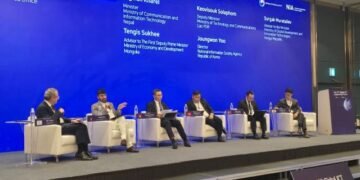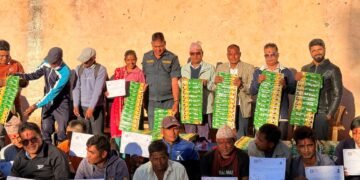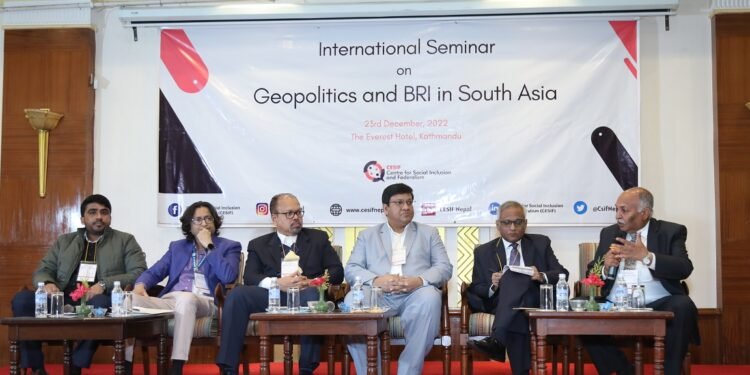KATHMANDU: With the motive to initiate a wider engagement of stakeholders to discuss the implications of China’s Belt and Road Initiative (BRI) in the South Asian region and to disseminate the research findings on “Prospects and Challenges of Nepal-China BRI Agreement”, Centre for Social Inclusion and Federalism (CESIF) organized the International Conference on ‘Geopolitics and BRI in South Asia’ on at The Everest Hotel, Kathmandu.
The conference brought together ex-ministers, analysts, academics, diplomats, bureaucrats, politicians, government officials, journalists and experts from South Asian Countries to discuss upon the issues surrounding China’s Belt and Road Initiative (BRI), its geopolitical implications, the fear of perceived “debt-trap diplomacy” of China and other country-specific concerns.
While addressing the seminar, Vijay Kant Karna said, “Although labelled as an initiative by China, BRI is a global strategic tool. With connectivity links and infrastructure projects spanning as many as one hundred and forty countries, China has aimed to create an alternative economic system with self at the center”. This could ultimately pose a challenge to the US-led liberal world order,” said Amb. Karna. Discussing upon varied interest of regional and global actors, he further added that, “the cause of concern isn’t that global and regional actors are seeking to advance their own interest in Nepal. In fact, that’s what all states do. The concern, however, is that, if Nepal will be able find the delicate geopolitical balance while still prioritizing its national interests.”
The seminar then proceeded with the first panel discussion on ‘BRI and Nepal-China Relations’ which brought together Dr. Prakash Sharan Mahat, former Minister for Foreign Affairs and present Member of Parliament; and Pradeep Kumar Gyawali, Former Minister for Foreign Affairs.
Dr. Mahat highlighted the importance of Nepal-China relationship; and claimed that the BRI carried both opportunities as well challenges for Nepal. He stressed that the further implementation of the BRI in Nepal should be strictly based on cost-benefit analysis. Talking about the provision of the Free Trade Agreement (FTA), he reiterated that Nepal shouldn’t move ahead with the provision, as it would be financially detrimental. Dr. Mahat also stressed that Nepal couldn’t accept commercial loans from any country and should rather negotiate for grants, and the same applied to the BRI projects.
Former Minister Gyawali, on the other hand, opined that Nepal should give a benefit of doubt to China’s BRI. While he too reiterated that Nepal couldn’t move ahead with commercial loans to undertake BRI infrastructure projects, he claimed that there still is a room for negotiation with China to insist for grants or concessional loans highlighting Nepal and China are yet to decide on the financing modality of the projects.
The seminar then witnessed a series of presentations by four international delegates from South Asia, who all provided their country-specific experiences with BRI.
Prof. Srikanth Kondapalli, dean of the School of International Studies and Professor of Chinese Studies at Jawaharlal Nehru University in India presented his opinions on ‘BRI Projects in the South Asia.’ Prof. Kondapalli highlighted that the BRI entailed Chinese strategic motive hidden under the guise of connectivity in South Asia and beyond. ‘While China claims to not interfere in the internal affairs of other countries, time and again, they have shown proclivity to do so as evident in parts of Africa,’ added Prof. Srikanth Kondapalli.
Harim Watson Peirish from Council for Public Policy (CCP) in Sri Lanka, presented on ‘Experiences and Implications of BRI in Sri Lanka.’ Peirish argued that the BRI wasn’t in the island nation’s interest. Peirish highlighted the case of Hambantota Port, which has been handed over to China by Sri Lanka in December 2017 being unable to payback Chinese loans. Peirish then added that the case of Hambantota port and the ongoing economic crisis also reflected a failure of the political leadership. “First and foremost, it was extremely imprudent on Sri Lanka’s part to accept Chinese loans with such high interest rate”, said Peirish.
Dr. Towfiqul Islam Khan from Centre for Policy Dialogue in Bangladesh provided his insights on ‘BRI in Bangladesh: Prospects and Challenges.’ Dr. Khan reflected upon various challenges associated with China’s BRI – particularly, the loan component with a higher interest rate, and a shorter payback period. “Generally, Chinese ODA are tied aid, and we (low-income countries) have fought a long to untie it and should continue to do so”, said Dr. Khan.
Dr. Devendra Kumar from Sai Nath University in India analyzed the complicated terrain of Sino-Indian rivalry. Dr. Kumar added that despite many avenues for collaboration between the two, and intricate financial and trade ties, the ongoing regional rivalry between is being further exacerbated by China’s aggressive approaches, and its pursuit of strategic endeavors with the initiatives such as the BRI.
Ajaya Bhadra Khanal stated that through policy exchange, China wants to actively encourage Nepal to adopt models of governance and development that can align with foreign policy interest of China – and this could pose challenge to our democratic practices.
The final panel on ‘Nepal-China BRI Agreement: Sectoral Perspectives’ brought together Purushottam Ojha, Former Secretary of Minister of Industry, Commerce and Supplies; Akhilesh Upadhyay, Senior Fellow at IIDS; Dr. Rupak Sapkota, Former Deputy Executive Director at Institute of Foreign Affairs and Shreeya Rana, Senior Program & Research Officer at PEI. The panel delved into overcoming the challenges of BRI to get better deals with China. The panel emphasized on the point that, Nepal could benefit from better connectivity ties with its northern neighbors but to be able to do so, it was imperative Nepal negotiate better with China. Further, the panel highlighted that Nepal could learn from the experiences of our regional neighbors in dealing with China, and use the benefit of being a late-starter to our own advantage. The panel to reiterated that Nepal shouldn’t move forward with FTA given the large trade gap with China, and that the loan component of the BRI remained a cause of concern.
As of August 2022, one hundred and forty-nine countries have signed the Memorandum of Understanding (MoU) on BRI. In South Asian region, five countries have already joined the Chinese initiative, while it has faced opposition from India right from the beginning. China claims that the BRI is aimed at building infrastructure network connecting Asia with other parts of the world along the overland Silk Road Economic Belt and the 21st Century Maritime Silk Road. In general, BRI has five major components – i) connectivity routes, ii) unimpeded trade, ii) policy coordination, iv) financial integration and v) people-to-people connectivity. Even though China prefers to portray BRI simply as an initiative which would create a “win-win scenario” to all the participating nations.
It is speculated that China has also employed this massive initiative to realize its ulterior strategic motives which has led to new geopolitical ramifications in the region. In case of Nepal, it has been five years since the signing of the MoU, however not a single project has been undertaken, nor any provisions implemented.





















